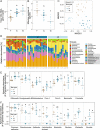Gut microbiota structure differs between honeybees in winter and summer
- PMID: 31836840
- PMCID: PMC7031341
- DOI: 10.1038/s41396-019-0568-8
Gut microbiota structure differs between honeybees in winter and summer
Abstract
Adult honeybees harbor a specialized gut microbiota of relatively low complexity. While seasonal differences in community composition have been reported, previous studies have focused on compositional changes rather than differences in absolute bacterial loads. Moreover, little is known about the gut microbiota of winter bees, which live much longer than bees during the foraging season, and which are critical for colony survival. We quantified seven core members of the bee gut microbiota in a single colony over 2 years and characterized the community composition in 14 colonies during summer and winter. Our data show that total bacterial loads substantially differ between foragers, nurses, and winter bees. Long-lived winter bees had the highest bacterial loads and the lowest community α-diversity, with a characteristic shift toward high levels of Bartonella and Commensalibacter, and a reduction of opportunistic colonizers. Using gnotobiotic bee experiments, we show that diet is a major contributor to the observed differences in bacterial loads. Overall, our study reveals that the gut microbiota of winter bees is remarkably different from foragers and nurses. Considering the importance of winter bees for colony survival, future work should focus on the role of the gut microbiota in winter bee health and disease.
Conflict of interest statement
The authors declare that they have no conflict of interest.
Figures



References
-
- Barron AB. Death of the bee hive: understanding the failure of an insect society. Curr Opin Insect Sci. 2015;10:45–50. - PubMed
-
- Nazzi F, Pennacchio F. Disentangling multiple interactions in the hive ecosystem. Trends Parasitol. 2014;30:556–61. - PubMed
-
- Goulson D, Nicholls E, Botías C, Rotheray EL. Bee declines driven by combined stress from parasites, pesticides, and lack of flowers. Science. 2015;347:1255957. - PubMed

